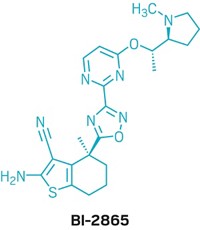Advertisement
Grab your lab coat. Let's get started
Welcome!
Welcome!
Create an account below to get 6 C&EN articles per month, receive newsletters and more - all free.
It seems this is your first time logging in online. Please enter the following information to continue.
As an ACS member you automatically get access to this site. All we need is few more details to create your reading experience.
Not you? Sign in with a different account.
Not you? Sign in with a different account.
ERROR 1
ERROR 1
ERROR 2
ERROR 2
ERROR 2
ERROR 2
ERROR 2
Password and Confirm password must match.
If you have an ACS member number, please enter it here so we can link this account to your membership. (optional)
ERROR 2
ACS values your privacy. By submitting your information, you are gaining access to C&EN and subscribing to our weekly newsletter. We use the information you provide to make your reading experience better, and we will never sell your data to third party members.
Biological Chemistry
The Long Road
Scientists worked for years to unravel Met's role in cancer
by Lisa M. Jarvis
August 20, 2007
| A version of this story appeared in
Volume 85, Issue 34
The tyrosine-kinasereceptor Met has become a hot target for drug companies, but it has been a long trek to translating the first bits of knowledge about the protein into today's potential treatments.
COVER STORY
The Long Road
George Vande Woude's lab at the National Cancer Institute's (NCI) Cancer Research & Development Center in Frederick, Md., first identified Met as a cancer-causing gene in 1984. For several years after its discovery, though, Met was an "orphan receptor," or one without a matching ligand to help explain its function, and progress toward understanding its role in cancer was slow. Because Met was found in so many kinds of tissues???both normal and cancerous???scientists couldn't be sure whether it was actually causing the disease.
"Here it was, showing up in a whole bunch of tumors, but there was still a question of whether it was involved with tumor genesis or not," says Vande Woude, now the research director of the Grand Rapids, Mich.-based Van Andel Institute.
The answer came when Vande Woude contacted an old friend and colleague, Stuart A. Aaronson, at NCI's Bethesda, Md., campus. Vande Woude had known Aaronson, then-chief of NCI's laboratory of cellular and molecular biology, since the early 1970s when they were starting out at the National Institutes of Health.
Aaronson had his own "orphan"—a growth factor without a matching receptor. Over lunch at a spot midway between their labs, scientists from the Vande Woude and Aaronson groups mapped out a series of experiments to test whether the orphan receptor was a match for the growth factor.
The meeting was fortuitous. By 1989, the scientists had shown that Aaronson's human growth factor (HGF) was the sole ligand for Met. "We were lucky, because this was our first test for HGF," says Aaronson, who is now chair of oncological sciences at Mount Sinai Medical Center in New York City. "There were about 15 tyrosine kinase receptors identified at that time, and probably 10 were still orphans."
Matching the ligand to the receptor confirmed that Met was not just a bystander in cancer but an actual player. "That gave a really important function to Met as a kinase involved in proliferation," Vande Woude notes.
Not much later, scientists determined that HGF was the same thing as "scatter factor," a protein that had separately been shown to push epithelial cells to scatter and migrate. Suddenly, it became clear that Met not only helped cancer cells to grow but also enabled them to spread beyond the initial tumor site.
Now, after more than 20 years of work, Met's dual activity has made it a prime target for drug developers. "It's amazing what's happening, and it's really just the beginning," Vande Woude says.




Join the conversation
Contact the reporter
Submit a Letter to the Editor for publication
Engage with us on Twitter